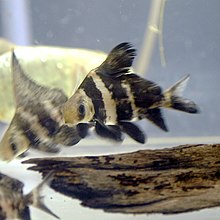Myxocyprinus
| Myxocyprinus | |
|---|---|

| |
| Juveniles | |
| Scientific classification | |
| Domain: | Eukaryota |
| Kingdom: | Animalia |
| Phylum: | Chordata |
| Class: | Actinopterygii |
| Order: | Cypriniformes |
| Family: | Catostomidae |
| Subfamily: | Myxocyprininae Fowler, 1958 |
| Genus: | Myxocyprinus (T. N. Gill, 1878) |
| Species: | M. asiaticus
|
| Binomial name | |
| Myxocyprinus asiaticus (Bleeker, 1864)
| |
| Synonyms[2] | |
| |
Myxocyprinus is a monotypic genus of freshwater fish in the monotypic subfamily Myxocyprininae within the family Catostomidae.[3][4] The only species is Myxocyprinus asiaticus, also known as the Chinese sucker.[3]
It is a popular freshwater aquarium fish[5] known under various common names, including Chinese high-fin banded shark,[6] Chinese banded shark, Chinese sailfin sucker,[7] high-fin (also spelled hi-fin[8]) banded loach, high-fin loach, Chinese high-fin sucker, sailfin sucker, topsail sucker, Asian sucker, wimple carp, wimple,[7] freshwater batfish, Hilsa herring, rough fish, Chinese or Asian zebra high-fin shark, Chinese or Asian zebra high-fin sucker,[5] Chinese emperor, Siamese sucker,[9] Chinese banded shark,[10] and entsuyui in Japanese. Despite its common names, it bears no relation to real sharks.[11] It grows to about 1.35 m (4 ft 5 in) long[12] and is unsuitable for most home aquariums.[13][7]
It has declined drastically due to pollution, dams (preventing its natural breeding migration), overfishing, introduced species and collection for the aquarium trade.[13][7][11] As a consequence it has been placed on the Chinese list of endangered species and is a state protected species.[13][11]
Description
[edit]
Young Chinese high-fin banded sharks normally possess brown bodies bearing three dark-colored slanting bands. During the breeding season, adult males are distinguished from adult females by their red coloration. Adult females are of dark purple color with a broad and vertical reddish area along the body. Juveniles of the Chinese high-fin banded sharks are also characterized by high and triangular dorsal finnage that extends up to the rear of the anal fin. The adult appearance is far less distinctive, as they are elongated in shape without the very high dorsal fin.[11] The thick and fleshy[5] lips bear small papillae without barbels. They have a single row of pharyngeal teeth that have comb-like arrangements.[14]
Through adulthood, Chinese high-fin banded sharks become darker in appearance. The characteristic pale bands found in young specimens disappear at a length of 30–36 cm (12–14 in),[13] and the species has been referred to as an "ugly duckling in reverse".[11] The growth is fast; it grows at the rate of one inch per year. Sexual maturity is reached when five to six years old and at least 60 cm (2 ft) long.[15] The maximum size reached by this fish is 1.35 m (4 ft 5 in) in length[12] and 40 kg (88 lb) in weight.[13]
Distribution and habitat
[edit]Chinese high-fin banded sharks are native to the Yangtze River basin of China.[14] They migrate into relatively fast flowing, shallow headwaters to spawn, but spend the remaining time in the main river sections.[13] The population in the Min River, a tributary of the Yangtze, may have been extirpated.[13]
The species is widely cultured in China to supply the food industry.[16]
Life span
[edit]In its natural habitat, Chinese high-fin banded sharks live for more than 25 years and reach sexual maturity when 5 to 6 years old.[12][13][15]
See also
[edit]References
[edit]- ^ Zhao, Y.; Zhang, E.; Wang, X.; Chen, X.; Jiang, Z.-G. (2023). "Myxocyprinus asiaticus". IUCN Red List of Threatened Species. 2023: e.T203326418A203326423. doi:10.2305/IUCN.UK.2023-1.RLTS.T203326418A203326423.en. Retrieved 10 December 2024.
- ^ "Myxocyprinus asiaticus (Bleeker, 1864)". Integrated Taxonomic Information System. Retrieved 10 December 2024.
- ^ a b Froese, Rainer; Pauly, Daniel (eds.). "Species in genus Myxocyprinus". FishBase. February 2024 version.
- ^ Eschmeyer, William N.; Fricke, Ron & van der Laan, Richard (eds.). "Myxocyprinus". Catalog of Fishes. California Academy of Sciences. Retrieved 10 August 2024.
- ^ a b c Freshwater batfish, Whozoo.org, December 1999, retrieved on: August 21, 2007 Archived September 27, 2007, at the Wayback Machine
- ^ "Chinese high fin banded shark, Chinese sucker - Myxocyprinus asiaticus". Aquaticcommunity.com.
- ^ a b c d Lundie, Adam. Myxocyprinus asiaticus, Fishprofiles.com, 2007, retrieved on: August 21, 2007.
- ^ "Photos of large hi-fin shark?". AquariumCentral.com.
- ^ Chinese emperor, WhoZoo.org, 2000, retrieved on: August 21, 2007 Archived February 23, 2007, at the Wayback Machine
- ^ Chinese banded shark (Myxocyprinus asiaticus), Aqua-Fish.net, 2007, retrieved on: August 21, 2007
- ^ a b c d e Koga, James S. Chinese high fin banded shark Archived 2016-08-15 at the Wayback Machine, Cal Poly Pomona, September 2003. Retrieved on 21 August 2007
- ^ a b c Fishing World Records: Myxocyprinus asiaticus. Retrieved 9 May 2013
- ^ a b c d e f g h SeriouslyFish: Myxocyprinus asiaticus. Retrieved 9 May 2013
- ^ a b Froese, Rainer; Pauly, Daniel (eds.). "Myxocyprinus asiaticus". FishBase. May 2013 version.
- ^ a b Chen, P. (2008). Ecological niche modeling as a predictive tool: Asiatic freshwater fishes in North America (Ph.D. thesis). University of Kansas. pp. 133–134. hdl:1808/4260.
- ^ Lin, Yucong; Gong, Yuan; Yuan, Yongchao; Gong, Shiyuan; Yu, Denghang; Li, Qiang; Luo, Zhi (2013). "Dietary L-lysine requirement of juvenile Chinese sucker, Myxocyprinus asiaticus". Aquaculture Research. 44 (10): 1539–1549. doi:10.1111/j.1365-2109.2012.03161.x.
External links
[edit]- Photograph at Mongabay.com
- IUCN Red List vulnerable species
- Catostomidae
- Endemic fauna of China
- Freshwater fish of China
- Taxa named by Theodore Gill
- Yangtze River
- Endangered fish
- Endangered fauna of Asia
- Monotypic fish genera
- Species that are or were threatened by damming
- Species that are or were threatened by pollution
- Endangered Fauna of China

